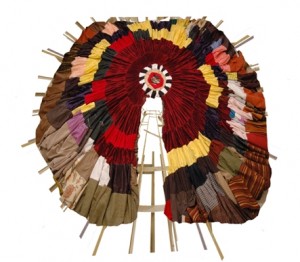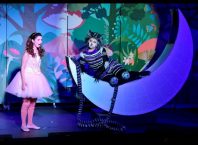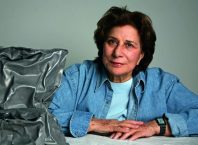Adjacent to the oldest Tel Aviv neighborhood, three renovated Templar buildings surround a spacious courtyard, with a tall, modern and very controversial Neve Tzedek tower on the side facing Eilat Street with its rows of stores leading into Yafo. Urban change and renewal, the conflicted co-existence of poverty and affluence, the hinged relationship between Tel Aviv and Yafo, history, religion, social issues, art and commerce – the exhibit is thought-provoking from the moment one approaches the area. In planning the exhibit, curators Moshenson and Sheleff sought artworks that relate to the city in general and Tel Aviv – Yafo in particular, it’s concepts and myths: the city that rose from the sand dunes, the White City, the Black City, the city that never sleeps. Rather than commission works for the exhibit, they selected contemporary paintings, photographs, video, sculpture and installations from both Israeli and international artists.
In true circus tradition, the Sideshow, curated by Michael Kessus Gedalyovich and Maayan Sheleff, pulls in the crowds. Beach mattresses that are and are not what they seem to be, are piled in the center of the courtyard, complete with beach umbrella, folding plastic chair and a television set showing people floating on the mattresses in the Mediterranean, all to the seductive sound of Mungo Jerry’s “In the Summertime”. “Go out and see what you can find,” indeed. So many thoughts and images come together in Shelly Federman’s outrageous and outrageously fun installation which creates the quintessential Tel Aviv moment: beach mattresses that appear to be made of concrete, looking eerily like the separation wall, yet are made of foam and can really float; the sound of water on the loudspeaker merges with the breeze from the sea, the Mediterranean on the screen and behind one’s back several yards away, involuntarily dancing to the beat while confronted by a reminder of the Israeli-Palestinian conflict.

As one enters the Wagner Bros. factory, the wood under-structure of Gili Avissar’s colorful skirt frames the wide door, with tv sets on either side showing the work in process, setting the mood for the room with its patchwork juxtaposition of fabrics, textures and colors, its evocation of traditional crafts contrasting with its very contemporary presentation, and sense of continual change and expansion. A group exhibit resembles city life in the connections created between works in proximity to one another, creating a new entity. Here, as one enters Wagner Bros. Factory, the sound of drumming from Fikret Atay’s video sets the room vibrating with its rhythm. The room itself interacts with and in a sense becomes part of the exhibit with its exposed wooden beams and stone floors: at once old and immaculately renovated.
The human landscape within the exhibit is also vibrant, dynamic, colorful and articulate. Observing Shay Id Alony’s wooden structures, an animated discussion began between two women. One was reminded of Russian church towers and at the same time struck by the way structures were cut to reveal the inner structure of the piece (which often contained another, different piece), and the other carried that image further to relate to other pieces in the room and current trends in Israeli culture – to reveal the inner workings of the body, mind and soul in all their gory splendor. Tracing the relationship between inner and outer structure, content and form in works such as Kader Attia’s empty plastic bags, literally empty and emptied of their function as they metamorphose into art, we enjoyed a lively discussion.

Mounir Fatmi’s “Skyline” exists in the tension between past and future, creativity and destruction, humor and despair: mounted on the wall is a skyline made out of black cassette tapes, creating an image of tall buildings with lots of windows, the tape itself unraveled and spilling out onto the floor, blinding sun glittering on the black. Tel Aviv often feels that way to me as I walk along its streets: a city where everything is falling apart, yet beautiful.
There is time to explore the rest of the exhibit, which includes two more buildings, through September 24th, especially as the opening hours make it the perfect place to visit after work. The art biennal is the initiative of Irit Fein-Sommer, Yehudit Haviv, Rivka Saker, and Shifra Shalit Intrator, central figures in the Israeli art scene. The biennial is planned to be held in tandem with the Istanbul and Athens biennials to create a sequence of art events in the area, connecting Israel to the international contemporary art scene.
In addition to the Universal Circus and Sideshows, the whole month of September and the city of Tel Aviv is dedicated to art, with numerous exhibits and events throughout the city. A map and schedule are available at the main desk of the Universal Circus.
Universal Circus will be on exhibit until September 24
Sunday – Thursday 16:00 – 22:00
Friday 10:00 – 14:00
Saturday 11:00 – 22:00
Closed for Rosh Hashana Holiday: September 18 – 20
Nechushtan Pavilion, 61 Eilat Street, Tel Aviv
Admission: 30 NIS (children under 12 free) with discounts for Tel Aviv residents, seniors, soldiers and student
Top image: Shelly Federman’s installation






there are many social issues that we face today but the biggest issue i think is poverty`.;
there are many social issues today that bothers us, hope we can solve everyone of them*-~
Comments are closed.